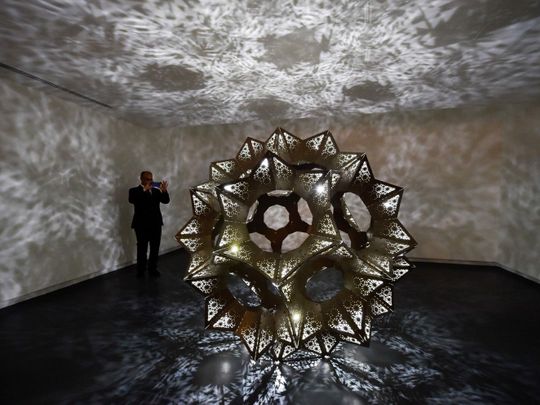
Washington Square Park is well-known to the habitués of Greenwich Village, the most hip neighbourhood in Lowe Manhattan. The park is where you go to sit on a bench and, well, watch non-conformity declare its own form of being, as folk singers jam and street performers do their thing.
To add pizzazz to its reputation, the park had also served as the setting for New York native Henry James’ 1880 novel, Washington Square.
The buildings surrounding the park have since the turn of the last century served as houses and studios for artists, writers, musicians, poets, beatniks and other bohemian elements. The buildings themselves have always been owned by New York University (NYU).
Founded in 1831, NYU, in addition to being a private research institution, is a global university with degree-granting campuses outside the United States, including Abu Dhabi, in the United Arab Emirates.
What our 90 Arab artists in question, whose work is currently on display at the Grey Gallery in New York, are saying to Americans is clear: This was our world in the post-colonial era, when both hope and despair informed our historical experience
Lofty mission
Our destination today, a mere one block up the street, is the Grey Art Gallery — located on campus within the Silver Centre — a fine art museum which distinguishes itself by emphasising art’s historical, cultural and social context, and claims its mission to be “the collection, study, interpretation and exhibition of evidence of human culture”. A lofty mission indeed, you will no doubt agree.
One could not think of a more serendipitous backdrop — an acclaimed park, a cool neighbourhood and a cosmopolitan academic institution — for the exhibition billed ‘Taking Shape: Abstraction from the Arab world, 1950s-1980s’, slated to run from January 14 to April 4. On display is a collection of 90 works — all drawn from the Barjeel Art Foundation in Sharjah, UAE — featuring sundry artists from most countries in the Arab Middle East and North Africa.
There is no other way of describing these works than to say they are stunning in their originality.
Though the artists’ abstraction here derives from calligraphy, the Islamic world’s classical art form, it appears to depart from it, seemingly to build on it, in effect creating a new art form, one already recognised as a movement called Hurrufia, a new experimental school in calligraphic art first pioneered by Iraqi artist Mediha Omar in the 1950s.
Diverse audiences
What these artists have sought to do is no less than to transform letter formations into abstract visual elements, or compositions, an endeavour that appears over the years to have garnered appreciation by diverse audiences in the Arab world and beyond.
The term “hurrufieh” does not yield well to a full translation into English, or any other language for that matter, but whichever way you choose to transfer it into another fashion of linguistic expression, it is a name given to a movement that seeks to release traditional Arabic calligraphy from the stringencies of classical rules.
By doing so, Hurrufia artists have made their art soar by transforming it into abstract expressionism, and enabled it, as if magically, to speak about and from the Pan-Arabist ethos that defined the era they depict in their work.
No one will disagree with Claude Levi Strauss, the renowned French anthropologist and member of the Academie Francaise (d. 2009), when he asserted that art, like music — two creative pursuits that no human community was unable to develop a tradition of — is “the supreme mystery of human being”. In short, the language of art, like that of music, is universal.
Collective consciousness
Still, art may speak of the inward preoccupations of working artists, but these preoccupations nevertheless originate from the collective consciousness of the culture of which they are a product.
Consider, in this regard, how the patronisation of the colonised “other” by 19th century European culture insinuated itself into the canvases of Orientalist artists, regardless of how “progressive” a mindset these artists had — and recall among them Eugene Delacroix’s painting, Women of Algiers in their Apartment (1834).
What our 90 Arab artists in question, whose work is currently on display at the Grey Gallery in New York, are saying to Americans is clear: This was our world in the post-colonial era, when both hope and despair informed our historical experience and shadowed our lives, and, additionally, we are saying that as artists we must, very simply, use the language of art to speak to you.
You walk out of the museum wondering how, while the voice of intellectuals in our part of the world, in our time, may have become blurred, — and in places, sadly, stilled — that of artists has become emboldened as those behind it master and transform traditional art forms with the proud intent of surpassing them. And they have done all that, well, artfully.
— Fawaz Turki is a journalist, lecturer and author based in Washington. He is the author of The Disinherited: Journal of a Palestinian Exile.









